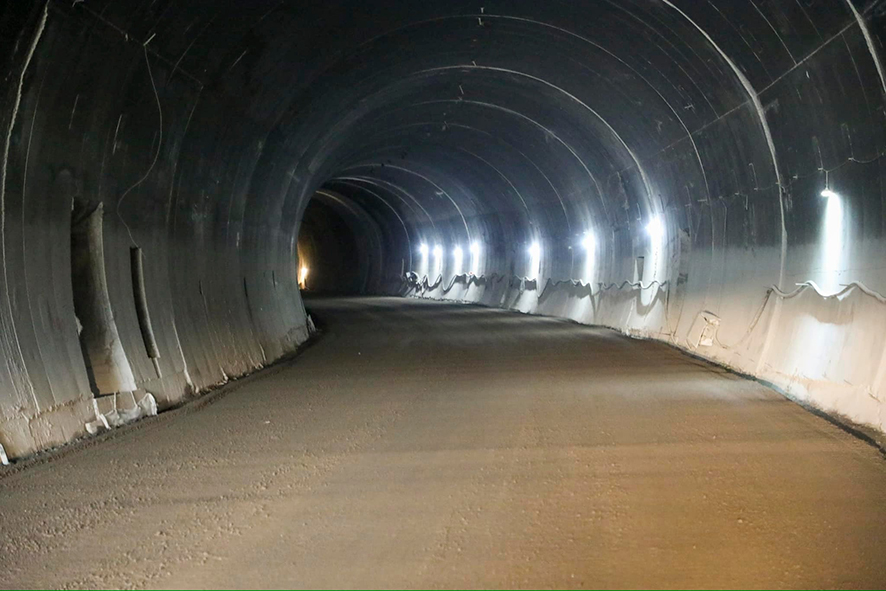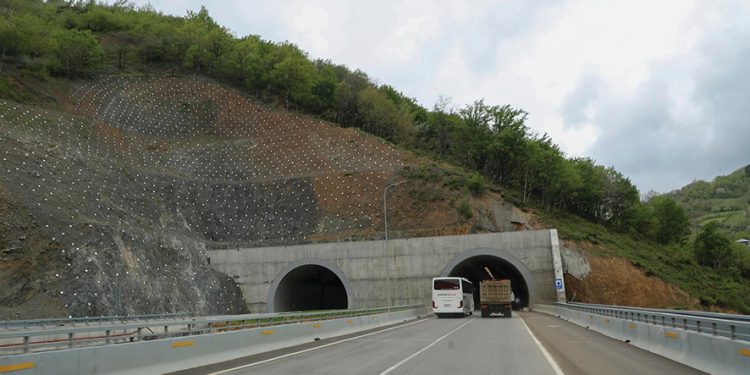Georgia’s East-West Highway carries over 60% of Georgia’s transit trade and cargo transit, as well as accommodating citizen and tourism flow. It is also celebrated as an asset to the country’s unique geographic location that helps connect Central Asia with Europe and East Asia.
Funding for the project has been provided by three main international donors: The Asian Development Bank (ADB), the World Bank (WB), and the European Investment Bank (EIB), while construction has been undertaken by various Chinese companies. The cost of constructing the highway was set at approximately GEL 3 billion (EUR 1 billion), and after experiencing significant delays, it is now slated for completion by the end of 2026.
The Asian Development Bank in particular helped improve four sections of the 410km (Tbilisi to Sarpi) East-West Highway, investing $300 mln for the Khevi-Ubisa section, $278 mln for the Zestaponi-Shorapani-Argveta section, $115 mln for the Kobuleti Bypass and $114 mln for the Batumi Bypass.
What is the East-West Highway?
The Georgian S1 route (Georgian: ს1, also known as Tbilisi-Senaki-Leselidze and the East-West Highway), is a “road of international importance” with a registered length of 542.7 kilometers, making it the longest Georgian highway route. It runs from Tbilisi via Mtskheta, Gori, Khashuri, Zestaponi, Kutaisi, Samtredia, Ureki, Kobuleti to Batumi then Sarpi on the Black Sea coast. It also veers north via Senaki, Zugdidi, Sukhumi and Gagra to the border with Russia at Leselidze, in the northwestern tip of the country. After crossing the Georgia–Russia border in breakaway Abkhazia, the highway continues to Sochi and Krasnodar as the A147. It is part of the European E60, E97 and E117 routes, and Asian Highways AH5, AH81 and AH82, and connects with six other S-routes.
The road reaches its highest point of 910m above sea level at the southern portal of the Rikoti Tunnel, which opened in 1982 as the longest vehicular tunnel entirely within Georgia, at 1,722 m.
(Photo) A tunnel under construction:

The East-West Highway Revamp
Since 2006, significant progress has been made within the East-West Highway (EWH) project, an initiative launched in 2005 to upgrade Georgia’s transportation infrastructure, seeking to realign and enhance the road to expressway or motorway standards and to improve operations and maintenance of the road network, as well as provide for better road safety. The ultimate aim is to establish a 455-kilometer east-west transport corridor across Georgia that links Azerbaijan and Armenia with Turkey. By upgrading sections of the E60 and E70 highways, particularly the Poti-Tbilisi-Red Bridge and Poti-Batumi-Sarpi routes, and by bypassing cities and towns, Georgia seeks to solidify its role as a pivotal transport hub in the South Caucasus region.
The project encompasses redesigning key segments of several Georgian highways, including the S1, S2, S4, S7 and S12, and turning them into grade-separated highways. While most of the East-West Highway was planned as a 2×2 expressway, some sections have been upgraded to grade-separated, two-lane highways with median separation and hard shoulders, as seen in the Kobuleti and Batumi bypasses.
The most difficult stretch of the old route spans over 50 kilometers and wound through the rugged and narrow Rikoti Pass, packed with challenging mountainous terrain. Prior to this project, the road was known for its bottlenecks, and too many lost their lives and cars to accidents caused by impatience, reckless drivers and wandering livestock.
Construction of the new highway in the Rikoti section was divided into four, with each segment treated as an independent project with its own environmental impact assessment, and with funding divided between the aforementioned financial institutions.
In September 2018, the ADB-funded, four-lane, 12-km road between Khevi and Ubisa was opened with 38 new bridges and 20 new tunnels to connect East and West Georgia through the Rikoti Pass. The road was built according to international standards, enabling safer travel, and shortening the road between the borders of the country.
In November 2019, a 14.7 km, dual two-lane carriageway, partly on a new alignment, between Shorapani and Argveta made it easier for vehicles to traverse the mountainous terrain, ravines, and river crossings in the area. At the end of April this year, the 9km Zestaponi part of this section was opened. Both were funded by ADB.
Two more sections of the Kobuleti Bypass, which was completed in 2019, have helped reduce traffic jams in Kobuleti resort and improve road safety and air quality, and work on the Batumi Bypass is well on its way to a year-end completion.
ADB notes that “The project will improve operations and maintenance of the road network, as well as road safety. Further, the project’s focus on a climate resilient design will contribute to mainstreaming the sustainability of Georgia’s road network.”

What did the locals think?
As the saying goes, “You can’t make an omelet without breaking eggs.” Naturally, rerouting segments, adding width, blasting through mountains and traversing rivers has meant that the environment, wildlife and citizens have all suffered.
Those who lost land and houses to the planning committee were of course compensated, while the birds, insects and other nature-dwellers have simply had to find alternative shelter away from the dust and noise for the time being.
“Local people were mostly supportive, having received compensation,” Mzia Giorgobiani, Deputy Minister of Regional Development and Infrastructure, tells GEORGIA TODAY. “There were some cases where they did not wish to be relocated, but ultimately the compensation persuaded them and, indeed, as I remember, we only had one big challenge from a gentleman living on the Kobuleti Bypass route, which was resolved through the court.”
As for the wildlife and greenery, Giorgobiani promises that, “For every tree cut, around three equivalent, native trees will be planted in parallel to the finishing works. Interestingly, while the legislation was not new with regards environmental impact and protection of the environment, and the activities are under the regulation of the donors [ADB, World Bank, EIB], in respect of the environment, Georgian legislation turned out to be much stricter.”
Further moves to placate the local people who now have a massive highway running past their windows included adding or reconstructing kindergartens and local civil service center buildings to improve overall education and connectivity standards.
Those, like me, who remember the “old road” will not only recall the rich green depths of the forests and fields we passed on the way, but will also remember the plethora of small business, through which villagers on the route scraped a reasonable income by selling seasonal fruit and vegetables (I can still picture the corn steaming in roadside pots), year-round produce like honey, sweet cinnamon bread (“nazuki”) and coffee, and local crafts – baskets, wooden cutting boards, ceramics and the like.
We asked Deputy Minister Giorgobiani and Levan Kupatashvili, Deputy Chairman of the Roads Department, what would happen to these local businesses.
“The honey, pottery and woodcrafting businesses, alongside those locals selling corn, nazuki and so on, will be able to relocate to four specially built stop-and-shop areas in the Rikoti zone, with safe, off-road parking, and a water supply,” Giorgobiani tells us. “We are interested in the road safety side as well as supporting local income, and these stop-and-shops will be very nice for everyone!”
“There were three popular places along the Rikoti route in particular,” Kupatashvili notes. “The ‘nazuki section’ in Surami, Shrosha for pottery and qvevri (wine amphora), and Zestaponi for coffee. We have included all three of these places in the [‘stop-and-shop’] project. The first two are in the final stages and Zestaponi is in the preparation stage. A fourth has been added at the road interchange. Once constructed, the municipality will take over care and maintenance, alongside the locals using the spaces to sell their goods.”

The Challenges They Faced
While overall celebrated as a beacon of progress and grandeur, the EWH project has at times been overshadowed by controversy. Public opinion has fluctuated, with the worst of the negativity fueled by frequent landslides and the resulting road closures, and the collapse of newly erected structures being touted by media as a potential threat to safety and welfare.
Challenges, such as the brief disruption caused by the 2008 Russo-Georgian War, and the Covid-19 restrictions (delaying material deliveries and slowing down the workforce), also naturally impacted the project’s timeline. Although earlier political commitments aimed for completion by 2020, construction on crucial sections is ongoing, with the remaining S1 segments slated for completion by 2026.
In February last year, the bridge over the Rioni river on the Japana-Samtredia stretch of the highway under construction collapsed under a truck. The Roads Department blamed the rising waters of the Rioni River, which damaged the 8th pier of the bridge. Thankfully, no one was injured in the incident.
Last year, landslides severely disrupted cross-country travel, caused by snowmelt shifting earth on the slopes near a World Bank-funded section of the highway. On March 30, 2023, authorities were forced to shut down the route due to the ongoing landslide activity. Despite efforts to implement detours, the alternate routes struggled to accommodate the increased traffic flow, resulting in traffic jams and delays. Local and international experts were called in and the affected section was adjusted and the route reopened.
Locals have also grown increasingly worried about the Rikotula River, long known for its floods and flash floods. Some areas of construction have narrowed the riverbed, and waste rock sites are affecting river flow, increasing the risk of destructive mudflows. Hydrologist Nika Tsitelashvili told bankwatch.org that the environmental impact assessment and hydrological reports lack current data and hydrological modelling, and locals are still waiting for their concerns to be properly addressed.
Aside from international-standard materials and construction, site safety and cleanup, and extremely thorough environmental impact assessments before, during and after, communication is key. All too often, a failure to communicate or correctly explain plans and projects with the people on the ground who will be most affected, as well as with wider society, leads to misinformed criticism, anger, and moves to put a spanner in the works.
The Roads Department claims it conducted 78 individual and group meetings among construction-affected communities on the 50-kilometer Rikoti route in 2023 alone.
“People have at times been focused on the message ‘it’s bad for nature,’ ‘the tunnel collapsed due to shoddy workmanship,’ or ‘they are using rusted steel for the bridges’ [ed.: It is international-standard corten steel], rather than recognizing that this project is good for our economy,” Kupatashvili points out. “The message wasn’t always given clearly, and media are naturally attracted to the scandals.”
Older travelers will also remember the infamous cows that drivers had to dodge, which local farmers let wander onto the high-speed road at grazing time, causing no end to the risk of accidents.
“Wandering cows were a regular problem on the highway,” Kupatashvili agrees. “But with World Bank financing, a huge campaign was run, and fences were installed along the main sections of the highway. Unfortunately, cows can still enter the road network via the intersections, but nothing can be done about that from our side. At least they keep the median looking tidy!” he jokes.
Light at the End of the Tunnel
With 96 bridges, 51 tunnels, over 6000 tons of steel, at least a million cubic meters of reinforced concrete, half a million square meters of protection (and that just in the Rikoti section of the revamped East-West Highway) – the monster project is inching ever closure to completion.
Within the Rikoti section, just the other side of the 1982 tunnel remains to be completed before cleanup, finishing and greening works can begin. Beyond that is the easier Kutaisi to Ureki section to finalize, and the next bottleneck: Batumi.
“Within the next two years, it will all be done,” Kupatashvili claims. “The worst is over. Khashuri was the biggest bottleneck – we tackled that first, then the Rikoti section, now this, the Zestaponi section [a 9km section with 17 bridges and 10 tunnels which opened at the end of April], which would see, even in the off-season, an hour long traffic jam to get through. The new road in this section shaves some 15-20 minutes of the journey time. Overall, we’re feeling comfortable. We’re not expecting any more surprises.”
Of the now-completed ADB-funded Rikoti sections of the EWH, Kupatashvili says: “Experts predicted it would take five years, our minister said two, we agreed on three, and got it done in four.”
In March, Minister of Regional Development and Infrastructure Irakli Karseladze announced that the Batumi Bypass, the next big obstacle, is well on track to being finished this year.
“Despite numerous challenges, the Batumi bypass road, our most demanding project, undergoing construction in difficult geological conditions, will be opened for the season. This is crucial for Batumi,” Karseladze told cbw.
The Batumi Bypass project, which will divert heavy traffic from Batumi and help boost trade and tourism, is a joint effort between the Roads Department of Georgia’s Ministry of Regional Development and Infrastructure, funded by a 329,630,734 GEL loan from the Asian Development Bank, and the Asian Infrastructure Investment Bank.
It involves constructing a 14 km dual-lane asphalt-concrete road, along with 20 bridge crossings and 5 tunnels.
With modern infrastructure, the huge East-West Highway projects are enabling safer travel and shorter travel times, with highway sections that divert heavy traffic from Georgian towns for fast transit movement and better health for residents. Sacrifices have had to be made, and not everyone is happy, but we can only hope that the outcomes will, as the government and investors claim, put the discomfort firmly in the past and contribute to a bright, better connected and economically stronger Georgia in the future.
A Bit of Interesting History
During the 1980s, the present-day S1 route (the East-West Highway) comprised the entirety of the Soviet M27 highway, which extended from Baku through Tbilisi to Novorossiysk. The Russian segment of the M27 remained intact until 2018, when it was redesignated as the A147 highway.
Following Georgia’s independence in 1991, the M27 designation persisted until 1996, when the current route numbering system was implemented. In the 1996 decree titled “Indicators and List for Determination of International, Domestic and Local Roads of Georgia,” the S1 route was documented as the “S1 Tbilisi – Senaki – Leselidze (Russian border),” spanning an original length of 552 kilometers (343 miles).
***
This article was inspired by the Asian Development Bank (ADB)’s April media tour for journalists based in Georgia, to the East-West Highway Khevi-Ubisa Section and Shorapani-Argveta Section.














